Listen to something a young woman in San Francisco said after the first weekend of protests following the killing of George Floyd.
“I personally have not been able to process everything that has gone on and is continuing to go on. But I will say as someone that is a young black person in their 20’s and has not witnessed the civil rights movement and all these other things that you read about in the history books, it is mind blowing to see all of what we see here but also recognizing now I’ve been compartmentalizing things for years…and it is deeply painful when you continue to tell stories about people who look like you and your family.”
That’s Jobina Fortson, a reporter for ABC station KGO, and she made those comments on the air. The powerful and candid reflections might seem unusual to long-time TV news viewers accustomed to “objective” reporters and anchors who rarely display emotion or never get personal. But the protests against police brutality and racism have touched off a conversation in newsrooms across America about the real meaning of “authenticity” and the evolving role of journalists in the digital age.
I spoke with Fortson’s general manager and six other thoughtful local station leaders about the sometimes tricky balancing act between traditional journalistic standards and credibility on the one hand and the natural instinct of up-and-coming journalists — often encouraged by their bosses — to express deeply held moral convictions, reflect their own life experiences, and connect with their viewers and followers in ways that are — well, human.

Tom Cibrowski, President and General Manager, KGO-TV
For Tom Cibrowski, “it really is about the evolution of both our audience and our employees. We can’t ignore generational change. And while our journalistic standards are sound, and we’re all trained to go after the story and the who, what, why, where, we have to understand that generations shift, audiences shift and our workforce shifts.”
The ability of journalists to engage directly with the public on social media has “changed the entire game,” Cibrowski says, and he wants KGO to meet the expectations of a new kind of viewer. “If you have people coming to you for the first time because there’s now a pandemic, or there are massive protests over George Floyd’s killing, you have to be ready, and your folks need to be comfortable with being a little more authentic. And the audience is now more inclined to be looking for who you are and what you stand for.”
We reported recently on a KGO town hall about links between the coronavirus epidemic and racism against Asian Americans, produced at the urging of two of the station’s Asian American anchors. (Similar programs focusing on the pandemic’s impact on Black and Latino communities followed.) This month, at the end of a televised and live-streamed roundtable discussion called “From Anger to Action,” the station encouraged anchors Eric Thomas and Kumasi Aaron, along with Jobina Fortson, to offer candid closing comments. And all three appear in a strong new station promo that might startle the old guard with its forthrightness.
Watch a KGO promo responding to the Floyd protests
“While Walter Cronkite represented the best journalistic values in the 1970s, we can still represent those journalistic values,” says Cibrowski, “but with people of new generations and different backgrounds, who can inform us and educate us even more.”
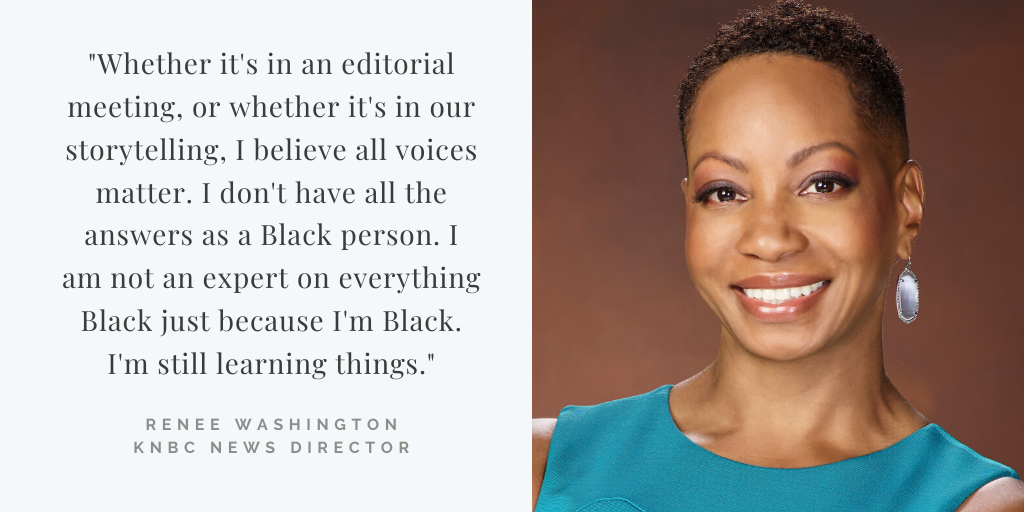
Renee Washington, VP of News, KNBC-TV
“It’s absolutely an issue in our newscasts,” says Renee Washington, who’s been news director at the NBC-owned LA station for just over a year. “Among our African American producers, among our Black reporters and anchors, and even for me, as a news leader, you want to make sure that you’re not letting your emotions…cloud your judgment when you’re reporting, and that you are reporting the facts, that you are getting both sides of the story, and that in some ways you are remaining neutral. Let’s draw the line at opinions.”
In today’s charged times, KNBC’s editorial meetings have become an important outlet for her staff. “Our editorial conversations tend to be where we allow people to express themselves more freely and at those times share their own experiences, and in some cases, share their opinions. But in the final product, we’ve got to remain neutral.”
Washington grants her people more leeway on social media and on a podcast called Shaky Town, although opinions about policy decisions are not welcome there either. But she acknowledges the challenge some of her colleagues experience covering this story. Washington remembers working in New York during the horrific Sandy Hook school massacre and seeing anchors and reporters break down occasionally on the air. “The same feeling of emotions and sadness and grief and despair is what Black people are feeling now,” she says. “So there probably will be moments where you have a reporter on the air who says, ‘You know what, as a Black person in this country, this one really touches home.’ And I think in order for viewers to be able to relate to you, at some point you do have to show a version of yourself that is authentic, and shows that you have empathy, and that this is something that you understand.”
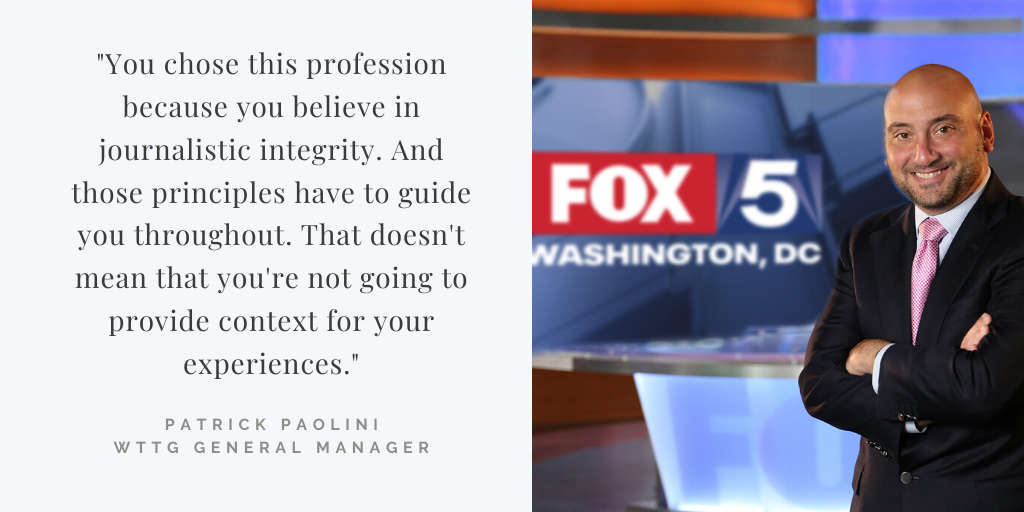
Patrick Paolini, SVP and General Manager, WTTG-TV
A brash, opinionated GM who even has his own podcast (we reported on “The Paolini Perspective” here), Patrick Paolini of Fox’s Washington D.C. station espouses traditional news values while encouraging his reporters and anchors to reflect their unique perspectives. “Journalistic integrity remains paramount. Fact-based journalism is absolutely critical at times like this, especially when the crisis is unfolding,” he says. “That doesn’t mean reporters and anchors aren’t going to bring their own sensibilities, their own experiences to those stories. And I think that’s okay.”
There has always been a window of acceptable subjectivity for television news reporters — topics about which there is widespread consensus in society. Expressing sadness or outrage about crimes against children has always been okay. Arguably, same-sex marriage (support) and climate change (concern) have moved into this category. Perhaps that window has widened to include racial injustice. “Systemic racism is wrong, period, end of story,” says Paolini. “So I think it’s okay that our talent communicates that to the viewer. Now when you start getting into policy…that’s where I think you have to get up to that line but not cross it.”
Paolini worries that social media has muddied an important distinction between fact and opinion. “I don’t think the standards should change, if they have, on local broadcast television, and I’m very serious about that. I think we do need to get back to the so-called ‘Walter Cronkite’ standards. And that doesn’t mean the delivery of that isn’t more authentic or conversational, but I think the standards have been blurred, and that’s a shame.”
No one has asked Paolini for permission to join a protest on his or her own time, but he says he wouldn’t rule it out, although he’d expect the reporter to disclose that “and then get back to fact-based journalism.”
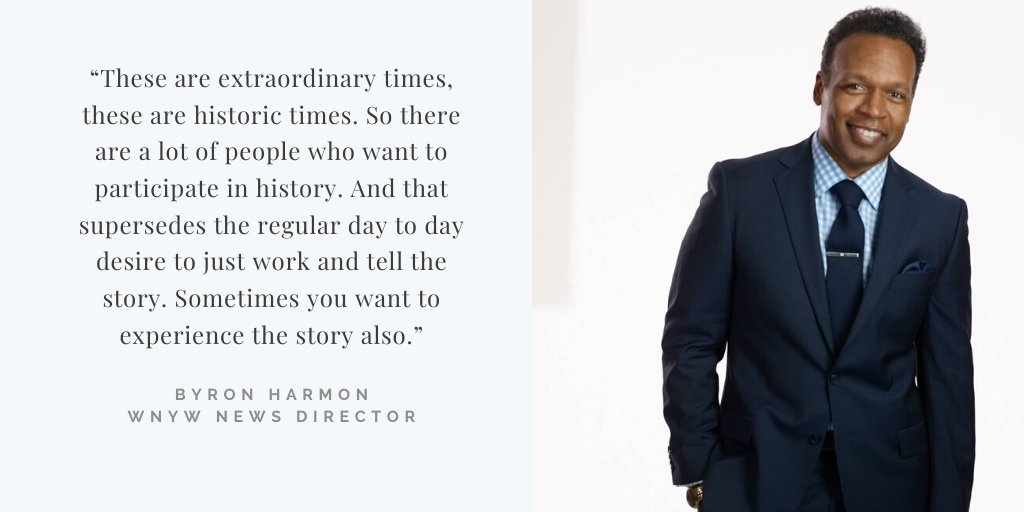
Byron Harmon, VP of News, WNYW-TV
None of Byron Harmon’s journalists has asked to join a march either, although like his colleague Patrick Paolini, he’s open to it. “I’m a Black man. I’ve had experiences and interactions with police officers that have not been great. So I have a different perspective on interacting with the police as opposed to someone who didn’t. And I can understand the feeling and this desire to go and be a part of something.”
Harmon, who’s proud of shaking up the culture at the Fox New York flagship, strongly encourages his people to bring their own perspective to the job. “I don’t have a problem with a reporter or staffer expressing a personal experience,” he says. “That’s what I do also. It would be on a case by case basis.”
Nevertheless, he acknowledges that the current wave of protests can be challenging for journalists and their bosses.”These are extraordinary times, so there’s a bit of gray area to work in with regards to maybe expanding traditional journalistic norms,” he says.
Harmon worries that social media may not be nuanced enough for the depth he wants his journalists to provide. “Social media doesn’t afford you the bandwidth to put things into context because it’s so immediate, it’s super diced up into small bits. And people are attracted to the heat of whatever it is you’re posting. I prefer to tackle a lot of these stories within our newscast in a way where we have enough time to put them into context. And if you want to add your own perspective into it, it’s a part of a much larger-focus narrative, as opposed to how you’re feeling in the moment.”

Jayne Ruben, News Director, KSLA-TV
“This is something that I would say I struggled with a bit at the beginning, because our mission is to be objective, we’re giving people information, and people can make up their own minds on how they feel and what the story means to them,” says Jayne Ruben, Gray’s news director in Shreveport LA. “However, when I watched that video for the first time, [my reaction] was ‘This can’t be real.’ It was disbelief that this was happening in front of millions of people’s eyes. And then you can’t help feeling sorrow, disbelief, anger. You’re in 2020. Why are we still dealing with this?”
Ruben’s team made national news recently by revealing disturbing new details about the death of Tommie Dale McGlothen, another Black man who died in police custody. “I think most people feel that this time there’s a difference in how people are reacting and how people are standing up for social injustice, standing up against systemic racism.”
“We strive to be factual and to share facts,” Ruben says — no partisanship allowed. But like other news leaders, Ruben encourages her reporters and anchors to share their “authentic selves” and engage directly with their community. “What is your passion? What are the things that you do in this community? You have to be a part of the community to know what those issues are that the audience wants to know about, that people here care about.”
Like Byron Harmon, Ruben addresses potential conflicts on a “case by case” basis, mostly in discussions with her colleagues. “The younger journalists need more guidelines and need stricter ‘This is what you can do, and this is what you can’t do,’ instead of anything’s fair game,” Ruben says, “because they’re just learning their way, and they’re just figuring it out.”
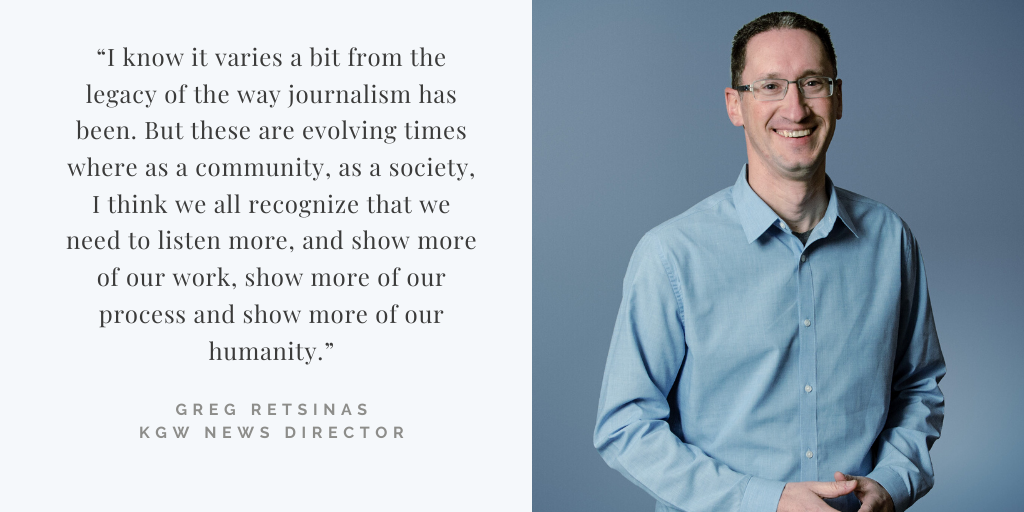
Greg Retsinas, News Director, KGW-TV
Greg Retsinas, news director at TEGNA’s Portland, Oregon station, wants his journalists to use their own experiences to enrich “the conversation” around today’s complex issues. “We’re not newsreaders here. We are journalists trying to help convey and improve communication and community in this society,” he says. “The reporters…need to feel empowered and emboldened and supported to be themselves and bring their own personal perspective to that conversation.”
Retsinas and his team are trying to re-invent the 6 p.m. news with The Story With Dan Haggerty, a newscast built around just a few in-depth reports and the highly personal take of its solo anchor. (We’ve reported on The Story and one of its inspirations, KUSA Denver’s Next With Kyle Clark.) Retsinas’s goal in all the station’s coverage is to balance journalistic ethics with personal perspectives. “We understand the value of bringing editorial independence and integrity to that process and not losing sight of that. It’s still being human about our own experiences.”
Like other leaders with whom we spoke, Retsinas sees the limits as well as the potential of social media. He encourages his colleagues to emphasize the quality of the conversation over more conventional metrics. “I tell our team, if you’re going to post something on social media, aim for quality that has context: less frequency, less quantity, less engagement-focused, more about quality, context, and aim for having a deeper conversation with fewer people. If you’re going to engage on social media, do that.”
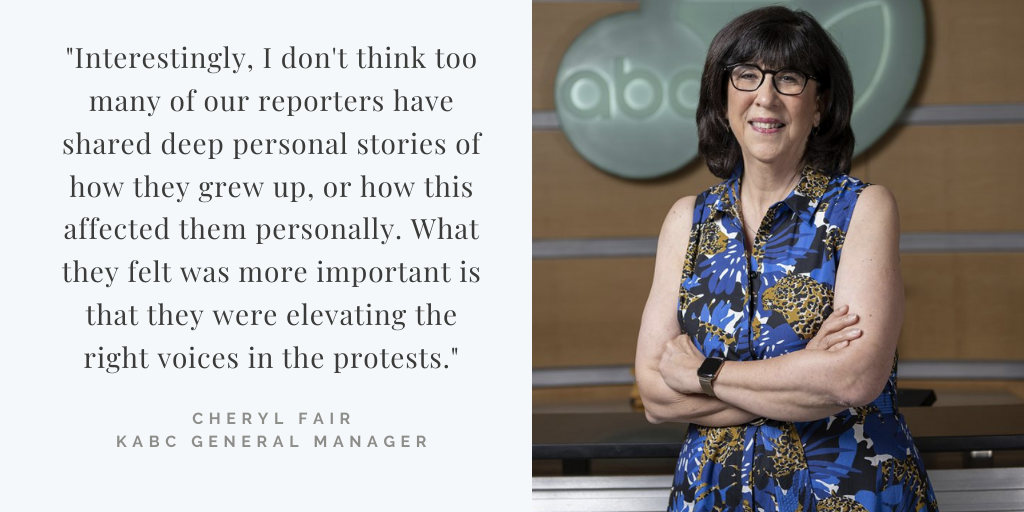
Cheryl Fair, President and General Manager, KABC-TV
Twenty-six years ago almost to the day — on June 17, 1994 — Cheryl Fair walked into the newsroom at KABC for the first time: she had just been appointed news director of the ABC-owned Los Angeles station, and this was supposed to be a quick visit to meet the team. But that afternoon, O.J. Simpson popped up in the now infamous white Bronco. “So that was my introduction to the question of race and social equity and justice in Los Angeles,” Fair says.
Fair never made it back home to Philadelphia, and she’s been at KABC ever since, except now she runs the place. She says a lot has changed in how the station covers news. When the protests touched off by George Floyd’s killing began, the newsroom got caught up in the fast-moving events, but “we all realized that night that we were going down the wrong path,” says Fair. “And we made a very quick pivot, because we realized that we were not providing the full story. And we made a concerted effort as a news department to go after the ‘why.’”
Going after the ‘why’ means going after context: longer interviews in newscasts, a wide-ranging array of experts and voices, and historical perspective from veteran anchors like Marc Brown, who was at the station covering O.J. and the L.A. riots two years before that. Fair’s community journalists, who are embedded in various neighborhoods rather than the newsroom, offer a range of perspectives from the streets where they live.
“As important as it is how our reporters feel personally — and it is important — and their voices are being heard, certainly internally,” says Fair, “I think the voices that we have decided are important to elevate here are the voices of the community in a meaningful and very obvious way. I think that part of what’s happening is [that] now we’re allowing people to tell their truth. And as long as our facts are correct, they can tell their truth.”
